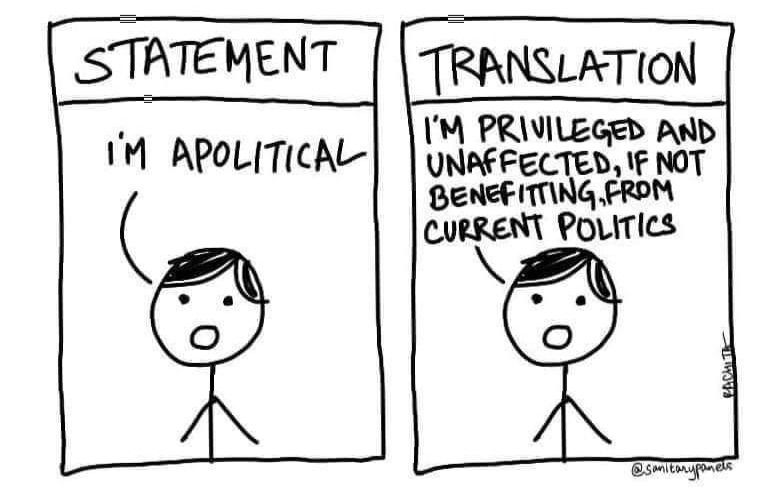Understanding the Political Compass: The paradox of being apolitical
- Akanksha Sharma
- Jun 18, 2023
- 3 min read
by Adhishri Aruman, London School of Economics
“If you stand for nothing Burr, what will you fall for?” (Hamilton)

As the largest democracy of the world (surpassing even the United States), India has failed to cater to the political participation of women, who account for almost half of the population of India. With the Universal Adult Franchise in place since the adoption of our constitution, the number of women who vote isn’t adequate enough to ensure their say in choosing their representative. Much more disappointing is the number of women who actually contest for the elections, reflecting the sparse representation of women in both the electoral and the decision-making processes.
This systematic exclusion of women from politics is not a linear exercise, but rather a more twisted element of the vaster toolkit of patriarchy, which has embedded itself into women’s consciousness since generations. As an undergrad myself at one of the most prestigious academic institutions in India, I have come across two strands of female students. One, who are very well-read, have a great academic understanding of politics, and are completely aware of the current developments in Indian politics and still choose to remain “apolitical”. They are the kind who are willing to have as many academic dialogues on anarchy, democracy, dystopia, politics, as you want, but who also actively disassociate themselves from any actual ground politics.
The second strand is made of female students who are completely unaware of any political concepts because they have never had the resources to read and understand politics or the chance to engage in conversations around the same, mostly either because they have been discouraged from the same or because they have been taught that politics is a man’s affair and a ‘dirty game’ that ‘good women’ are not a part of. Hence, this strand also chooses to stay away from politics and make no efforts to understand the key principles. I have, on many occasions, called many women out for being apolitical with the sheer confidence in the idea that they are well-aware and are still choosing to not get involved, hence, letting the prominent ideas dominate their lives.
However, I have also come to acknowledge that most women are not even cognisant of the fact that politics pervades all the domains of our lives and that most of our everyday choices reflect a big part of our political leaning. Choices as small as advocating for our own right to education, convincing our parents to send us to a different city for higher studies, complaining about hostel curfews, checking our privilege and many more define, shape and reflect our general stance on the political compass. And yet, when asked, many of us inevitably choose to respond ambiguously as to where we stand.
In my opinion, one of the first step towards involving women in the conversation is to understand what a political compass is and that even though the left and right are not completely applicable in the Indian context, it is still one of the most fundamental concepts that govern the dynamics of any form or level of government or governance. The Political Spectrum/Compass is a way of distinguishing political ideologies along one axis or more that can be used to compare them. One of the most influential political spectrums that introduced the left/right dichotomy originated during the French Revolution when the French National Assembly met at Versailles in 1789. The political left and right have, for centuries, shaped the way we look at politics in general.
The Political Left is usually associated with the beliefs in political, social and economic equality, state control over institutions of power and social welfare as the most important objective that the government should strive for. They oppose the traditional elites and advocate for the rights of the working class. The Political Right is usually associated with the conservative beliefs of faith in the existing institutions, meritocracy, state-market control over institutions of power, and are comfortable with the set traditions and are firm supporters of authority and hierarchy.
This is a very concise and simplified explanation of what a political compass looks like and it can be much more complicated and immersed in our lifestyles. The ways of our life knowingly and unknowingly are very political. And we cannot, in any case whatsoever, have a stance that is “apolitical”. Silence is being witness to the power. However, as mentioned before, we need to be cautious in assuming that women deliberately choose to be apolitical, as there is, clearly, more patterns at work here, which need to be constantly decoded and unlearnt in order to bolster women’s voices in the political processes.
References-
Eldridge, Stephen. "political spectrum". Encyclopedia Britannica, 22 Mar. 2023, https://www.britannica.com/topic/political-spectrum. Accessed 4 June 2023.
Britannica, The Editors of Encyclopaedia. "left". Encyclopedia Britannica, 12 Mar. 2020, https://www.britannica.com/topic/left. Accessed 4 June 2023.
Britannica, The Editors of Encyclopaedia. "right". Encyclopedia Britannica, 9 May. 2023, https://www.britannica.com/topic/right. Accessed 4 June 2023.



Comments